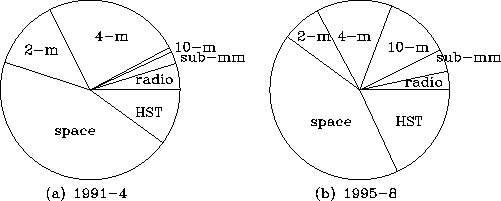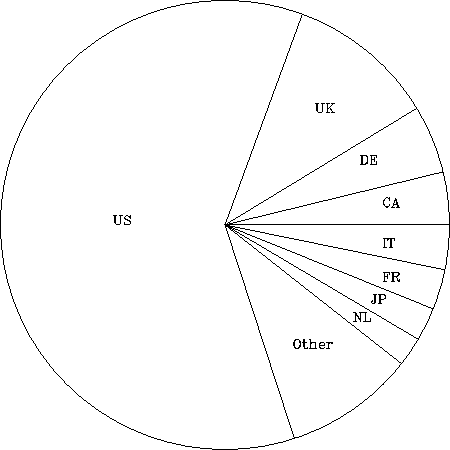 | |||
|
| Home > Astronomy > William Herschel Telescope > Scientific impact of large telescopes 1991-8 |
 | |||
|
| Home > Astronomy > William Herschel Telescope > Scientific impact of large telescopes 1991-8 |
Scientific impact of large telescopes 1991-8Below we summarise the results from our analysis of the 1000 top-cited astrophysics papers 1991-8, under the following headings:

In Benn & Sanchez (2001, PASP, 113, 385), we presented a detailed analysis of the relative scientific impact of individual ground-based and space telescopes. The WHT had more articles in Nature than any other ground-based optical telescope during this period, and 1995-8 WHT papers in all journals garnered more citations than those from any other ground-based optical telescope apart from Keck and CFHT.
Our findings were discussed in a news feature in Nature (2000 Nov 2, p.12).

In
Sanchez & Benn
(2004, Astr. Nachr., 325, 445), we used the same 1991-8 citations
database to measure the relative scientific impact of different
countries.
Institution Country Papers Citations
91-4 95-8 91-8 1991-4 1995-8 1991-8
Harvard USA 25 25 50 5.2 4.9 5.1
GSFC USA 20 33 53 4.1 6.0 5.1
Princeton USA 28 20 48 4.9 3.8 4.3
Caltech USA 13 24 37 2.3 5.7 4.0
IOACambridge UK 22 12 34 4.6 2.7 3.6
STScI USA 16 16 32 2.6 4.0 3.3
Berkeley USA 13 12 25 3.7 2.1 2.9
Hawaii USA 12 15 27 2.5 2.8 2.7
Arizona USA 13 14 27 2.3 3.0 2.7
Durham UK 4 13 17 0.8 3.2 2.0
UCSC USA 13 6 19 2.2 1.6 1.9
MPIE Germany 11 8 19 2.0 1.5 1.8
Geneva Switzerland 10 2 12 2.7 0.7 1.7
LLNL USA 5 6 11 1.7 1.7 1.7
Carnegie USA 10 10 20 1.8 1.6 1.7
Toronto Canada 7 9 16 1.2 2.0 1.6
MIT USA 9 6 15 1.4 1.0 1.2
JHU USA 4 10 14 0.6 1.8 1.2
MPIA Germany 4 10 14 0.5 1.7 1.1
Tokyo Japan 3 7 10 0.8 1.2 1.0
Amsterdam Netherlands 2 9 11 0.3 1.7 1.0
Oxford UK 9 0 9 2.0 0.0 1.0
NRAO USA 5 3 8 1.0 0.9 1.0
Mt. Stromlo Australia 5 5 10 1.3 0.8 1.0
Yvette France 4 5 9 0.9 0.8 0.8
UCSD USA 3 4 7 0.6 1.0 0.8
Leicester UK 6 1 7 1.5 0.2 0.8
Wisc./Madison USA 5 2 7 1.0 0.3 0.7
UCSB USA 4 1 5 1.3 0.2 0.7
MPIH Germany 5 3 8 0.9 0.4 0.7
Note that only the institution of the first author has been considered. The top 5 are large institutions: Harvard, GSFC (both institutions publishing a mixture of solar-system, stellar and extragalactic work), Princeton (hot stars, extragalactic), Caltech (mostly extragalactic) and IOA Cambridge (all extragalactic), with no significant change in productivity between 1991 and 1998. Abt (1993, PASP, 105, 437), using a count of published papers, found the top 4 US institutions to be Harvard, GSFC, Caltech and STScI. The top 4 non-US institutions after IOA Cambridge are the University of Durham, the Max Planck Institute for Extraterrestrial Physics in Garching, Geneva Observatory and the University of Toronto. The Durham and Toronto papers are all on extragalactic topics, most of those from MPIE and Geneva are on stars. LLNL = Lawrence Livermore, USA; MPIA = Max Planck Inst. Astrophysics, Munich; MPIE = Max Planck Inst. Extraterrestrial Physics, Garching; MPIH = Max Planck Inst. Astronomy, Heidelberg. These results are not published elsewhere.The ISI citations database gives the surname and initials of the first author of each paper. The 1000 top papers 1991-8 include 732 different names for first author. The most frequent are C. Alcock (5), J.N. Bahcall (6), R.C. Kennicutt (6), R. Narayan (9) and S.E. Woosley (6), all publishing from the USA. Of the 16 authors with 4 or more entries, 13 publish mainly from the USA, 1 from USA/NL, 1 from Canada, and 1 from UK/Germany. Their papers are on a variety of high-profile topics, e.g. microlensing, gamma-ray bursts, advection-dominated accretion, dark matter, measurement of the Hubble constant. Seven of the 60 authors (12%) with 3 or more papers in the top 1000 are UK-based. Below are listed first authors with 3 or more papers amongst the top-cited 1000 from 1991-8.
Papers Author 9 NARAYAN R 6 BAHCALL JN 6 KENNICUTT RC 6 WOOSLEY SE 5 ALCOCK C 4 BARNES JE 4 COWIE LL 4 KAUFFMANN G 4 LANZETTA KM 4 LILLY SJ 4 MADAU P 4 MUSHOTZKY RF 4 NAVARRO JF 4 STEIDEL CC 4 VANDERMAREL RP 4 WHITE SDM 3 BAHCALL NA 3 BAUGH CM 3 BENNETT CL 3 BURROWS A 3 CARLBERG RG 3 CEN RY 3 CHABOYER B 3 CONDON JJ 3 EDGE AC 3 ELLIS RS 3 EVRARD AE 3 FABIAN AC 3 FISHER KB 3 FUKUGITA M 3 GORSKI KM 3 HAARDT F 3 HASINGER G 3 HENRY JP 3 HILLENBRAND LA 3 HOLTZMAN JA 3 IGLESIAS CA 3 KATZ N 3 KOUVELIOTOU C 3 MAEDER A 3 MCWILLIAM A 3 MIRABEL IF 3 MOORE B 3 MULCHAEY JS 3 NANDRA K 3 PACZYNSKI B 3 PEACOCK JA 3 PETTINI M 3 RIESS AG 3 SAHA A 3 SANDAGE A 3 SCOVILLE NZ 3 SONGAILA A 3 STONE JM 3 TANAKA Y 3 THOMPSON DJ 3 WAXMAN E 3 WORTHEY G 3 WRIGHT ELAccording to Schulman et al (1997, PASP, 109, 1278), the fraction of single-author papers in the astronomical literature declined from 40% in 1975 to 14% in 1995. In the ISI database, the fraction of papers with one author declined from 13 to 8% over 1991 to 1998, that with 1-4 authors from 71 to 54%, that with 5-8 authors is approximately constant, and that with > 8 authors has risen from 13 to 26%. There is no correlation between number of authors and citation ranking of paper. The paper with the largest number of authors (103) is by Korista et al (1995). The median number of authors for papers using data from 4-m class or smaller ground-based telescopes is 4. The median for Keck and HST is 6. Most of the papers with more than 10 authors are based on data from space telescopes.
|
| Top | Back |
|